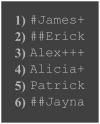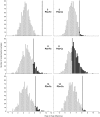Subliminal salience search illustrated: EEG identity and deception detection on the fringe of awareness
- PMID: 23372697
- PMCID: PMC3553137
- DOI: 10.1371/journal.pone.0054258
Subliminal salience search illustrated: EEG identity and deception detection on the fringe of awareness
Abstract
We propose a novel deception detection system based on Rapid Serial Visual Presentation (RSVP). One motivation for the new method is to present stimuli on the fringe of awareness, such that it is more difficult for deceivers to confound the deception test using countermeasures. The proposed system is able to detect identity deception (by using the first names of participants) with a 100% hit rate (at an alpha level of 0.05). To achieve this, we extended the classic Event-Related Potential (ERP) techniques (such as peak-to-peak) by applying Randomisation, a form of Monte Carlo resampling, which we used to detect deception at an individual level. In order to make the deployment of the system simple and rapid, we utilised data from three electrodes only: Fz, Cz and Pz. We then combined data from the three electrodes using Fisher's method so that each participant was assigned a single p-value, which represents the combined probability that a specific participant was being deceptive. We also present subliminal salience search as a general method to determine what participants find salient by detecting breakthrough into conscious awareness using EEG.
Conflict of interest statement
Figures











Similar articles
-
Countering countermeasures: detecting identity lies by detecting conscious breakthrough.PLoS One. 2014 Mar 7;9(3):e90595. doi: 10.1371/journal.pone.0090595. eCollection 2014. PLoS One. 2014. PMID: 24608749 Free PMC article. Clinical Trial.
-
Breakthrough percepts of famous faces.Psychophysiology. 2019 Jan;56(1):e13279. doi: 10.1111/psyp.13279. Epub 2018 Oct 4. Psychophysiology. 2019. PMID: 30288755
-
Wavelet analysis for EEG feature extraction in deception detection.Conf Proc IEEE Eng Med Biol Soc. 2006;2006:2434-7. doi: 10.1109/IEMBS.2006.260247. Conf Proc IEEE Eng Med Biol Soc. 2006. PMID: 17946114
-
ERP and MEG correlates of visual consciousness: The second decade.Conscious Cogn. 2020 Apr;80:102917. doi: 10.1016/j.concog.2020.102917. Epub 2020 Mar 16. Conscious Cogn. 2020. PMID: 32193077 Review.
-
Tracking the processes behind conscious perception: a review of event-related potential correlates of visual consciousness.Conscious Cogn. 2011 Sep;20(3):972-83. doi: 10.1016/j.concog.2011.03.019. Epub 2011 Apr 8. Conscious Cogn. 2011. PMID: 21482150 Review.
Cited by
-
The cost of space independence in P300-BCI spellers.J Neuroeng Rehabil. 2013 Jul 29;10:82. doi: 10.1186/1743-0003-10-82. J Neuroeng Rehabil. 2013. PMID: 23895406 Free PMC article.
-
Can prediction error explain predictability effects on the N1 during picture-word verification?Imaging Neurosci (Camb). 2024 Apr 8;2:imag-2-00131. doi: 10.1162/imag_a_00131. eCollection 2024. Imaging Neurosci (Camb). 2024. PMID: 40800525 Free PMC article.
-
The effect of mental countermeasures on neuroimaging-based concealed information tests.Hum Brain Mapp. 2019 Jul;40(10):2899-2916. doi: 10.1002/hbm.24567. Epub 2019 Mar 12. Hum Brain Mapp. 2019. PMID: 30864277 Free PMC article.
-
Item Roles Explored in a Modified P300-Based CTP Concealed Information Test.Appl Psychophysiol Biofeedback. 2019 Sep;44(3):195-209. doi: 10.1007/s10484-019-09430-6. Appl Psychophysiol Biofeedback. 2019. PMID: 30969387 Free PMC article.
-
Identifying the location of a concealed object through unintentional eye movements.Front Psychol. 2015 Apr 8;6:381. doi: 10.3389/fpsyg.2015.00381. eCollection 2015. Front Psychol. 2015. PMID: 25904879 Free PMC article.
References
-
- Lawrence DH (1971) Two studies of visual search for word targets with controlled rates of presentation. Perception & Psychophysics 10: 85–89.
-
- Potter MC (1976) Short-term conceptual memory for pictures. Journal of Experimental Psychology: Human Learning and Memory 2: 509. - PubMed
-
- Luck SJ, Vogel EK, Shapiro KL (1996) Word meanings can be accessed but not reported during the attentional blink. Nature 383: 616–618. - PubMed
-
- Bowman H, Wyble B (2007) The simultaneous type, serial token model of temporal attention and working memory. Psychological Review; Psychological Review 114: 38–70. - PubMed
Publication types
MeSH terms
LinkOut - more resources
Full Text Sources
Other Literature Sources

